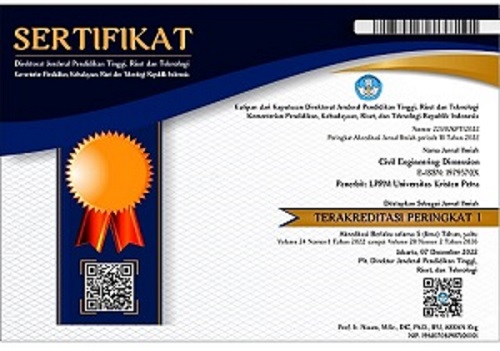Community-Based Approach in A Small Scale Irrigation Project in Indonesia: Ways and Advantages
 :
:
https://doi.org/10.9744/ced.17.2.95-100
Keywords:
Community-based, small scale irrigation project, advantages, policyAbstract
The implementation of community-based approach, where community can control a government owned infrastructure project, is rarely found. However, Sumatra River Basin Organization (BWSS) V successfully implemented a small scale irrigation project using this method in West Sumatra Province, Indonesia. This paper aims to describe how this policy was implemented, highlight its milestones, and discuss the advantages of its application. A detailed literature review and semi structured interviews were conducted to achieve the objectives. It was found that the implementation of community-based approach can bring about a sense of belonging, sustainability, and a source of income for the community. Hence, the project was finished on time within budget with high quality materials. In some cases the quantity of the project was more than it was targeted. The key policy that contributed to the success was trusting community to control the project and making sure that the proposed project came from the community.
References
Davidson, C.H., Johnson, C., Lizarralde, G., Dikmen, N., and Sliwinski, A., Truths and Myths about Community Participation in Post-disaster Housing Projects, Habitat International, 31, 2007, pp. 100–115.[CrossRef]
Dercon, B. and Kusumawijaya, M., Two Years of Settlement Recovery in Aceh and Nias: What should the Planners have Learned?, 43rd ISOCARP Congress, Antwerp, Belgium, September 19-23, 2007.
Jha, A. K., Barenstein, J. D., Phelps, P. M., Pittet, D., and Sena, S., Safer Homes, Stronger Communities: A Handbook for Reconstructing after Natural Disasters, Washington: The World Bank, 2010.[CrossRef]
MacRae, G. and Hodgkin, D., Half Full or Half Empty? Shelter after the Jogjakarta Earthquake, Disasters, 35(1), 2011, pp. 243-267.[CrossRef]
Kumar, C., Revisiting ‘Community’ in Community-based Natural Resource Management, Community Development Journal, 40(3), 2005, pp. 275-285.[CrossRef]
Choguill, M.B.G., A Ladder of Community Participation for Underdeveloped Countries, Habitat International, 20(3), 1996, pp. 431-444.[CrossRef]
Arnstein, S.R., A Ladder of Citizen Participation, Journal of the American Institute of Planners, 35(4), 1969, pp. 216-224.[CrossRef]
Ophiyandri, T., Amaratunga, D., and Pathirage, C., Community Based Post Disaster Housing Reconstruction: Indonesian Perspective, Proceeding of CIB World Congress, Salford, United Kingdom, May 10-13, 2010.
QSR International (2015) NVivo 10 for Windows, available at www.qsrinternational.com/ products_nvivo.aspx, accessed on 30 August 2015.
BWSS V, Technical Guidance: Program for Acceleration and Development of Water Resources Infrastructure-Small Scale Irrigation (P4-ISDA-IK), Sumatera River Basin Organization V (BWSS V), 2014.
BWSS V, Final Report: P4-ISDA-IK. Sumatera River Basin Organization V (BWSS V), 2015.
Downloads
Published
How to Cite
Issue
Section
License
Authors who publish with this journal agree to the following terms:- Authors retain the copyright and publishing right, and grant the journal right of first publication with the work simultaneously licensed under a Creative Commons Attribution License that allows others to share the work with an acknowledgement of the work's authorship and initial publication in this journal.
- Authors are able to enter into separate, additional contractual arrangements for the non-exclusive distribution of the journal's published version of the work (e.g., post it to an institutional repository or publish it in a book), with an acknowledgement of its initial publication in this journal.
- Authors are permitted and encouraged to post their work online (e.g., in institutional repositories or on their website) followingthe publication of the article, as it can lead to productive exchanges, as well as earlier and greater citation of published work (See The Effect of Open Access).
















